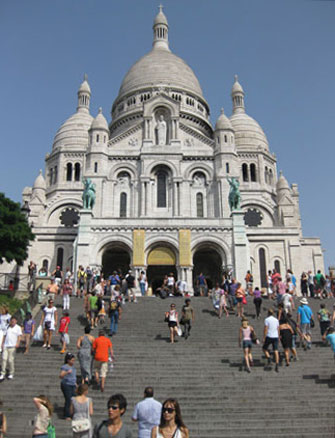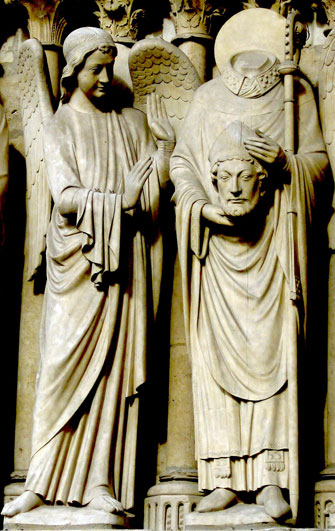
The highest point in the city of Paris is the Butte de Montmartre, “Martyrs Hill,” so-called because, according to legend, this was where Saint Denis, the patron saint of France, was beheaded by the Romans in approximately 250 CE.
The date is not the only thing about the story that’s difficult to verify. Again according to legend, after he was deprived of his second most valued appendage, Saint Denis stood up, leaned over, seized his own head and walked with it for 10 kilometers due north, finally collapsing at the site where now stands the Basilica of Saint Denis in a suburb called, for reasons that have baffled historians for centuries, Saint Denis.
I have always wondered why the old tête toter walked north, into what was then uninhabited fields and forests, instead of south toward the center of town, where he could at least get a decent last meal. My guess is that with his head cut off he lost his sense of orientation and (obvious “guy joke” alert!) refused to ask for directions.
In any case, that’s why Saint Denis is always depicted with his head literally in his hands:

Some years went by after that memorable event, like about 1.62 millennia, and the Montmartre hill once again became the focus of attention in Paris after the Franco-Prussian War. For the benefit of American readers who glanced out the window and therefore missed the one-eighth of a second devoted to French history in the U.S. public schools, this was a war that France fought in 1870-71 against Poland and Russia, which were angry with the French for making fun of them (it was a running joke in Parisian society to refer derisively to any country east of France as “Prussia”).
After the war, Paris was embroiled in another conflict, pitting the national government against the Commune, a popular uprising that sought to give “power to the people.” Although the Commune ruled the city for two months in early 1871, most of the power directed at the people came in the form of firepower.
Tens of thousands of Communards were killed in the fighting or executed after the government regained control. Once the dust had settled and the guillotines had been hosed down, the authorities decided to build a big snow-globe-worthy cathedral on top of Montmartre in memory of the country’s new martyrs, those killed in the war and in the events surrounding the Commune.
The result is Sacré Coeur de Montmartre, the Basilica of the Sacred Heart. Today’s visitors may not know much about acephalous saints and so-called “Prussians,” but the church’s physical beauty, location and panoramic view of the city make it a powerful magnet for tourists. Which in turn makes it a 10,000-watt scrap yard magnet for the many species of parasitic fauna who feed on tourist wallets: beggars, buskers, hucksters, shysters and run-of-the-mill thieves.
If you want to get a gander at Sacré Coeur today, you have to run a gauntlet of people whose goal in life is to siphon the cash out of your money belt. This urban Odyssey starts at the nearest Métro station, Anvers, where you will be greeted by what is quite possibly the highest concentration of pickpockets known to man.
I guess if I were a cutpurse I’d pick the location, too. There’s only one exit from the station and one narrow street leading up to the basilica, plus a double row of tour-bus parking, so about 80 percent of the visitors to Sacré Coeur on any given day are funneled like livestock in a never-ending stream through one small, densely crowded zone. For a pickpocket, it’s like dynamite fishing in a stocked barrel.
Did you make it past the dodgeurs plein d’art? Well hang onto your handbag, because two blocks up the road, you’ll be given another golden opportunity to be fleeced: this is a prime location for three-card-monte dealers.
It astounds me that this “game” still exists. Apparently there are still people alive and old enough to walk who have never heard of this age-old scam. For the benefit of readers who were born this morning, here’s an explanation:
Three-card monte is a variant of the shell game, a swindle that was invented about one hour after the Big Bang. In the modern version, a smooth-talking guy lays out three cards face down on a flat surface and invites passers-by to bet on their ability to pick the winning card, typically a queen, from among the other two.
It looks really easy and he flashes a fat roll of banknotes to show that there is money to be won. After a minute or so, another guy — whom the dealer has never seen before in his life because this is a perfectly legitimate game of pure skill, which is why you only ever see it played in the street on a cardboard box — steps up to the table and bets a fifty that he can do it. Solely due to his intelligence and powers of perception, he wins.
The idea is that eventually an onlooker, or what is known as a “mark” in the business and a “fatuous idiot” everywhere else, will place a bet. Solely due to circumstance and sheer coincidence, this person loses. Because solely due to circumstance and sheer coincidence, the dealer is actually using four cards, keeping one palmed, and exerting 100 percent control over the outcome of every round.
In other words, if you’re stupid enough to play this game, you’re not betting that you can find the queen, you’re betting that the dealer will suddenly decide that he doesn’t want your money after all. Good luck!
Since you’re reading C’est Ironique, you obviously have enough sense to give the Montmartre monte men a miss, but you’re not out of the forest of finaglers yet. When you arrive at the bottom of the steps leading up to the basilica, you will probably find another con going on: a group of guys trying to convince passers-by to let them braid colored yarn on their finger as a “lucky charm.”
As far as I know, this is just an elaborate begging technique. Or rather the provision of a trivial, useless and inconvenient (who wants a lanyard of yarn attached to their index finger all day?) service in exchange for a “tip.”
Some people claim that the yarn weavers are stealing rings, but I find it hard to believe — the process requires both of the braider’s hands and takes place with the braidee staring at his or her own fingers the entire time. In any case, if you fall for this one, any “luck” involved will be theirs, not yours.
And you’re not done yet! At the top of the first set of steps you will in all likelihood be met by a gaggle of young girls who want very, very badly for you to sign a petition to support a “school for deaf children.”
Guess what? The petitions are fake, there is no school, and they’re not deaf (although they probably speak virtually no French, English or anything else you can understand, so pretending to be mute is a fairly clever gambit). It’s either a premise for begging — after signing you’re supposed to “make a contribution” — or a distraction for picking your pocket, or both.
Once you slalom past the petite petitioners, there’s another shorter flight of steps to negotiate, which is usually dotted with street performers, mostly buskers and “human statue” mimes. Unimpressive as their unsolicited services might be, at least there’s no hard sell involved.
Accompanying the talent show, such as it is, you will usually find a small army of street vendors hawking cheap Chinese-made tchotchke replicas of the Eiffel Tower. At least until a police car drives by — then they flee, heading over to the Eiffel Tower to sell cheap Chinese-made tchotchke replicas of Sacré Coeur.
One last short flight of steps, and you arrive, harried and breathless, at the door of the basilica itself. Where there is invariably an insistent, keening beggar on duty. They work in shifts to make sure that no one gets inside without a pre-mass guilt trip.
I find it interesting that the solicitations around Sacré Coeur are organized, as though by intelligent design, in descending order of criminality as you ascend the hill. At the bottom are the outright felons (the pickpockets), followed by the misdemeanor men (the monte dealers). Then you encounter the fraudulent beggars (yarn charmers and petition pushers), followed by the ISP beggars (itinerant service providers like mimes and musicians), culminating in good old-fashioned bald-faced begging at the door.
It would seem that, for the socioeconomic leeches of Montmartre, the closer they get to Paris’s sacred heart, the less evil lurks in their own. Maybe there really is something holy about that particular hill. Nothing to lose your head over, though.
Reader Allan Gray writes: “I’ve encountered every one of these scam artists up there, as well as around the Louvre and Eiffel Tower, but there is one honest person (I think) — the elderly gentleman in the wheelchair making cats out of pipe cleaners for €2 euros each right in front of the steps up to the church.”
Reader Barney Kirchhoff writes:“David, you’re overly pessimistic. I have a friend who makes a modest living doing quick portraits there and delivers good value.
“If you ever go to New York, I have another friend who will sell you a share of Brooklyn Bridge.”
© 2012 Paris Update
FavoriteAn album of David Jaggard’s comic compositions is now available for streaming on Spotify and Apple Music, for purchase (whole or track by track) on iTunes and Amazon, and on every other music downloading service in the known universe, under the title “Totally Unrelated.”
Note to readers: David Jaggard’s e-book Quorum of One: Satire 1998-2011 is available from Amazon as well as iTunes, iBookstore, Nook, Reader Store, Kobo, Copia and many other distributors.
